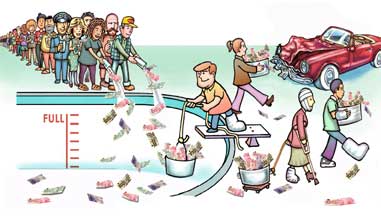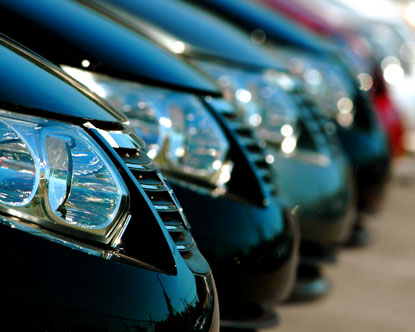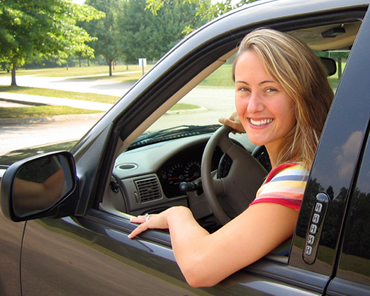
by Colin Moor, CAIB | Jul 12, 2011 | Research Centre
While it may seem complex, insurance is really quite simple: The payments (or premiums) of the many pay for the losses of a few.
Your premiums go into a large pool, if you will, at your insurance company. The claims of the few are paid from that pool. Because there are more people contributing to the pool than there are making claims, there is always enough to pay the claims – even large single claims like when someone is permanently disabled as a result of a car collision, or many smaller claims like those resulting from a natural disaster. (The 1998 ice storm that hit parts of Ontario, Quebec and New Brunswick resulted in an estimated 700,000 claims for damage totalling $1.4 billion.) However, large disasters (such as the ice storm) do come close to emptying the pool.

Insurance for insurance companies
Even when the pool comes close to emptying, there is another pool from which insurance companies can draw to pay claims. Some of your premiums are used by your insurance company to buy reinsurance – insurance for insurance companies.
Sometimes losses are so big – like those resulting from an earthquake – that there is no way that an insurance company can cover the costs. Reinsurance is an extra layer of protection against large losses.
Annual replenishing
Your insurance is an annual contract, so the pool operates for only one year at a time.
Your premiums and the premiums of others are based on how much money the insurance companies think they will need to pay the coming year’s claims. Your premiums do not build up over the years – unlike the premiums for some types of life insurance.
How premiums are calculated
Within reasonable limits, some of which are prescribed by law, your premium is calculated to reflect the probability that you will make a claim – that is, that you will draw funds from the insurance pool. Those who are unlikely to draw from the pool pay less than those who are more likely to draw from it.
Insurers take many factors into consideration to determine the likelihood that you will make a claim. A common misconception is that a policyholder who has never made a claim should pay less, little or nothing for insurance. While it is true that past claims history is important, a more reliable indicator of how likely a person or business is to make a claim is the statistical group to which he/she/it belongs.
Industry earnings
Insurance companies generally do not make money on the premiums gathered from policyholders.
In 2005, insurance companies paid more than $21 billion in claims while taking in $35 billion in premiums. The difference between the premiums and claims, in this case $14 billion, is used by the companies to pay salaries and taxes ($6.2 billion in 2005), and to cover the overhead costs (such as electricity bills) of running a business. It is also used to pay the administrative costs of settling a claim.
Insurance pays for …
Insurance pays for only those types of losses described in your contract. It is very important that you read your policy and/or talk to your insurance broker about what you are covered for and what you’re not.
Insurance will not pay for every problem that you may encounter, nor is it a maintenance contract.
Insurance is generally intended – and priced accordingly – to help policyholders cope with the financial consequences of unpredictable events that are “sudden and accidental.”
If, for example, you live on a floodplain by a river, flooding of your property in the spring is not sudden or accidental; it is inevitable and, therefore, uninsurable.
Source: Insurance Bureau of Canada

by Eddie Rodriguez, CAIB | Jul 11, 2011 | Research Centre
You can get sideways with your insurance company because you haven’t been upfront about how you are using your vehicle.
For example, do you drive your car to work? If so, you will pay more for auto insurance than if you take mass transit. In fact, the further you have to drive to work, the more you will pay.
* Tip. If you drive to work and tell your insurance company you don’t, you have basically committed fraud. Resist this temptation, even if it might save you a few dollars.
* Example. Say you have an accident on the way to work. Say, also, that you have told your insurance company you don’t drive to work. Your insurer could technically argue that it is not obligated to provide coverage and you’ve given them a good reason to cancel your policy.
Honesty is the best policy when it comes to insurance. Insurance fraud is a huge problem in North America, and Ontario is no exception; claims are frequently padded with nonexistent damages; accidents are staged and injuries are faked.
* Fact. It is estimated that fraud accounts for as much as 25 cents to 30 cents of every auto insurance premium dollar. Think about that. If even half the auto insurance fraud in in North America were wiped out in the next year, you would pay 12% to 15% less for your next policy.

Personal Car for Business, Company Car for Personal Use
Do you use your personal car for business?
Do you have access to a company car?
If the answer to either question is yes, you could have potential coverage gaps.
* Example. Let’s say you use your personal car for business. It’s possible your employer is providing some coverage for you through your employer’s commercial auto policy. In most cases the coverage is for liability only, and often this commercial auto policy doesn’t even apply until the limits on your personal auto policy are exhausted. (This is what insurance people call “excess” coverage.)
* Tip. You should talk to your employer about what, if any, coverage is available to you through the company’s commercial auto policy. That way, if you have an accident while on company business, you know who (or which insurance company) to call.
If you use your personal car for regular business purposes – trips, visiting clients, etc. – your personal auto policy probably provides enough coverage for these activities. (Assuming you have “enough” coverage to begin with.)
But what if your car is actually a source of revenue? You make deliveries, for example. In that case, you likely need a commercial auto policy as well.
* Note. If you have an accident while delivering a product or using your car as a taxi, your personal auto insurer may deny your claim. Talk to your broker to make sure you have coverage for all the business activities for which you use your car.
What about company cars? They can be an insurance problem, if you use the company car for business and pleasure, particularly if you don’t have a car of your own.
If you don’t have a car, you probably don’t have a personal auto policy. If you don’t have a car (or personal auto coverage) and use a company vehicle for pleasure, you are inviting disaster if you have an accident during a pleasure trip.
* Tip. If you are in this situation, you should have what is called a non-owned personal auto policy.
Such a policy can also come in handy if you don’t have a car and you rent a vehicle on a trip. Your non-owned auto policy will cover you and your rental car if you have an accident. Otherwise, you would probably need to buy coverage from the rental car company, coverage that is very, very expensive.
* Tip. You can have coverage gaps even if you have a personal auto policy and use a company car for pleasure or if your spouse or children use the company car for pleasure. Find out from your employer the extent of coverage that is available for your corporate car. Once you know the extent, talk to your MIB insurance broker about any additional coverage you might need.

by Eddie Rodriguez, CAIB | Jul 11, 2011 | Research Centre
All the coverages in your auto policy apply when you are driving, but they also apply when other people are driving your vehicle.
The coverages are actually for the car, not the person.
* Note. If someone is going to be a regular user of your car, that person’s name needs to be added to the policy.
Your insurance company wants to know who’s going to be using the car. After all, you could be a great driver with no tickets or accidents, but your spouse, your teenage child, or your reckless cousin could be a lousy driver.
If you let these people drive your car without telling your insurer and these people keep getting in accidents, your insurance company isn’t going to be happy. In fact, they may cancel your policy.

* Tip. It’s not wise to risk losing your policy by failing to disclose who’s driving the insured vehicle. Keep in mind, however, that if you add drivers with lousy records or who haven’t had much driving experience, your premiums will go up.
Any parent of a driving teenager can tell you this; teenagers are notorious for getting tickets and having accidents. They are also very inexperienced drivers. As such, when your child gets his or her license, your insurance premiums will go up when he or she is added to the policy. (There are a few exceptions to this … In some cases, your premium will NOT go up when adding a young, inexperienced driver).
This is a complex issue, and you’re better off to contact your MIB broker and tell him/her what your particular situation is.

by Eddie Rodriguez, CAIB | Jul 11, 2011 | Research Centre
In addition to buying “optional coverages” for extra protection, you have the option to increase the coverage of some of the mandatory coverages you already have (such as the Liability and Accident Benefits).
Let’s talk about that briefly:
How much insurance do you need?
Bodily Injury Liability
You can buy the minimum required by law: $200,000. Or you can buy limits as high as $1000,000, even $2 million. Remember that someone you hit can sue you for everything you have.
* Tip. If you have a home, own stock and have a decent income, you should probably buy, at minimum, limits of 1 million. If you have more than $300,000 in assets, you should buy higher limits or an umbrella policy. Consult with your professional broker about this!
Property Damage Liability
Several years ago, the $200,000 minimum was considered “more than enough” for this coverage. Not anymore. You should seriously considerat least 2 million of coverage.
In Ontario, the limit you select form “Bodily Injury Liability” will automatically be the same limit you’ll buy for “Property Damage Liability” and for the “Family Protection Coverage” we mentioned in this other article.

Collision
Consider how much you can afford to pay to have your car fixed if you have an accident. Auto policies have several deductible options.
* Note. A deductible is the part you pay before the insurance kicks in. You can buy deductibles of $500, even $1,000. The lower the deductible, the more this coverage will cost.
Unless you’re planning to have a lot of accidents, it’s probably a good idea to have a deductible of at least five hundred dollars. (By the way, the “collision deductible” does not apply if someone else hits you and that person is charged “100% at fault” by their insurance company. – If the other person is found only “50% at fault” (as an example), then you would have to pay 50% of your deductible.)
Comprehensive
Like collision, there’s a deductible with comprehensive, although it is often lower. For example, if you have a $500 deductible for collision, your comprehensive deductible may be, say, $300.
* Note. While collision and comprehensive will pay for damage or loss to your car, neither coverage will pay for everything on or in your vehicle. Most policies exclude things like CB radios, two-way radios, car phones, cassettes and CDs. – The “contents” of your car, may be covered by your homeowner’s, condo owner’s or renter’s insurance policy … if you have one.
If you add special features to pickups, vans or SUVS, these things probably will be excluded as well. In fact, it’s a good idea for you to talk to your insurance broker about any high-tech equipment or special features you have added to your vehicle. Many, perhaps even most, of these features aren’t covered in the standard policy. It is possible, however, to obtain special coverage for any high-tech equipment or special features your vehicle may have.
Your MIB broker can advise you of the options.

by Eddie Rodriguez, CAIB | Jul 11, 2011 | Research Centre
There are some additional coverages you can buy.
You can buy rental reimbursement (“Loss of Use“), which will pay for a rental car while your vehicle is being repaired. ( If the accident was not your fault, the cost of the rental car is automatically picked up by your insurance company .. subject to some exceptions).
If the accident is completely – or partially – your fault, you’d be covered for the Car rental cost IF you’ve bought the optional “Loss of Use” coverage.
If you’re not sure whether you’ve purchased this coverage, let us know and we’ll check your policy for you ]
If you are buying or leasing a NEW vehicle (a private passenger automibilie or a snowmobile), you can buy the “Removing Depreciation Deduction” endorsement: Under certain conditions, this endorsement waves depreciation when setting physical damage loss to new vehicles for set period of time following purchase. If your car is written off during this period you would be reimbursed the original purchase price (instead of the probably-much-lower current value).
Another very popular optional coverage (which you can buy IF you qualify) is the A.P.E …
… no, not that APE in the picture!
I’m talking about the A.P.E: Accident Protection Endorsement. This relatively-inexpensive coverage would protect you from having to pay a higher premium after your first AT-FAULT accident.
What if you damage a vehicle you don’t own … such as a rented car?!!!
Yup, you can get coverage for that (assuming you qualify). In Ontario this is known as the OPCF27. By adding an “OPCF 27” to your automobile policy, you won’t have to worry about buying extra insurance whenever you rent a car ……… Unless in cases when it would make sense to buy the insurance from the rental company. Feel free to ask an MIB broker about this to make sure you don’t waste your money.

by Eddie Rodriguez, CAIB | Jul 11, 2011 | Research Centre
Auto insurance is a product with a few distinct coverages.
Let’s look at them briefly here:
1. Bodily Injury Liability (Mandatory)- This pays the medical and other expenses of those people injured or even killed in accidents you cause. In Ontario, you are required to have a minimum coverage of $200,000.
2. Property Damage Liability (Mandatory)- This covers the damage your car causes to property such as garages, buildings, lampposts, fences, whatever. This is also mandatory in Ontario, with a minimum required coverage of $200,000.
3. “Accident Benefits” (Medical Payments, etc.) (Mandatory) – This pays medical, and even funeral, expenses for you as well as members of your family and passengers in your car if it is involved in a collision, regardless of who caused the accident. It also covers you as a pedestrian if a vehicle hits you.

*TIP: This very complex section of the Ontario Automobile Policy changed as of September 2011 – Ask your MIB broker about the differences, and find out if you need to increase your coverages to the “old standards”.
4. Direct Compensation – Property Damage (Mandatory) – Under certain conditions, covers you in Ontario for damage to your automobile and to property it is carrying when another motorist is responsible.
* Why is it called “Direct Compensation”? Because you’re directly compensated by your own insurance company – even though another party is fully or partially responsible – This saves you the expense and trouble of having to sue the other party and wait a long time to get your car fixed.
5. Uninsured Automobile (Mandatory) – This coverage protects you if you are injured or killed by an UNinsured motorist or by a hit-and-run driver. It also covers damage to your automobile caused by an identified uninsured motorist . (By the way, that’s an over-simplified summary of a very complex part of the Ontario Auto Policy).
* Fines for vehicle owners, lessees and drivers who do not carry valid automobile insurance can range from $5,000 to $50,000 …. And still, there are lots of people out there driving WITHOUT insurance. One report estimates that 1 in every 20 Ontario drivers is driving WITHOUT insurance.
6. Comprehensive – This OPTIONAL but highly recommended coverage includes protection against certain “specified perils” (^ ^see below.) as well as other insured damage to your car resulting from something other than a collision with another vehicle (See “Collision” below). For example, the Comprehensive coverage will pay for damage caused by vandals or a wind-blown tree hitting your car.
^ ^ In regards to Specified Perils the Ontario Automobile Policy says: “we will only pay for losses caused by fire; theft or attempted theft; lightning, windstorm, hail, or rising water; earthquake; explosion; riot or civil disturbance; falling or forced landing of aircraft or parts of aircraft; or the stranding, sinking, burning, derailment or collision of any kind of transport in, or upon which a described automobile is being carried on land or water”.
7. Collision – This OPTIONAL but highly recommended coverage is for damage done to your car when it collides with other vehicles (your fault) or other objects (again, your fault).
It also covers damage to your vehicle caused by an unidentified vehicle or object. For example: you park in the parking lot of the convenience store and go in to buy something …. When you come out of the store, you notice that your car has been hit and damage by another car … but the other driver took off and no one saw him or her. In this case, your policy would cover damage to your car IF you have this OPTIONAL coverage.
In Ontario, instead of buying the Collision and Comprehensive coverages separately, you can get the “All Perils” option.
What is it?
All Perils (OPTIONAL) -this option combines the coverages of Collision or Upset and Comprehensive.
In addition, this coverage (All Perils) includes loss or damage caused if a person who lives in your household steals a described automobile. Coverage also applies if an employee who drives or uses, services or repairs a described automobile, steals it.
In Ontario we also pay for an important type of protection called “Family Protection Coverage” (OPCF 44R) – Some find the name (Family Protection Coverage) misleading or confusing. Let’s clarify briefly what this coverage does for you:
You see, many of those who do have insurance don’t have enough to cover the damages and injuries that would result in a major collision.
What if YOU getting into accident with someone who doesn’t have ENOUGH insurance for the damages they cause to you?
If you don’t have this coverage, which is often referred to as Under-Insured motorist, you are taking a risk.
If you do have this coverage, your insurance company will pay (or as they say: “indemnify an eligible claimant”) for the amount that you are legally entitled to recover from an inadequately insured motorist as compensatory damages in respect of bodily injury to or death of an insured person arising directly or indirectly from the use or operation of an automobile.







